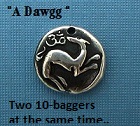Posted On: 10/21/2015 7:49:40 AM
Post# of 63832
Salty, I remember when a good number of people
could afford to have a pair of snow or winter tires.
They were street legal a few months a year.
I had a pair of studded tires for 10 years or so.
I took them on and off..
They sure did rumble of dry pavement..

Wikipedia
Snow tires - often also called winter tires - are tires designed for use in colder weather, snow and ice. Snow chains can be a slower-speed, temporary alternative in snowy conditions. Snow tires have more sipes than summer tires, increasing traction on snow and ice.[1] Tires designed for winter conditions are optimized to drive at temperatures below 7 °C (45 °F).
Studded tires with metal pins that protrude from the tire can greatly reduce skidding and accidents on snow or ice-covered roads. However, the metal studs make contact to the road pavement which eventually cut into the pavement allowing water to get in. The water can cause road damage and create hydroplaning hazard.[2]
could afford to have a pair of snow or winter tires.
They were street legal a few months a year.
I had a pair of studded tires for 10 years or so.
I took them on and off..
They sure did rumble of dry pavement..

Wikipedia
Snow tires - often also called winter tires - are tires designed for use in colder weather, snow and ice. Snow chains can be a slower-speed, temporary alternative in snowy conditions. Snow tires have more sipes than summer tires, increasing traction on snow and ice.[1] Tires designed for winter conditions are optimized to drive at temperatures below 7 °C (45 °F).
Studded tires with metal pins that protrude from the tire can greatly reduce skidding and accidents on snow or ice-covered roads. However, the metal studs make contact to the road pavement which eventually cut into the pavement allowing water to get in. The water can cause road damage and create hydroplaning hazard.[2]

